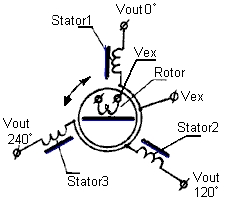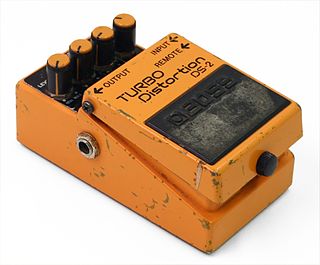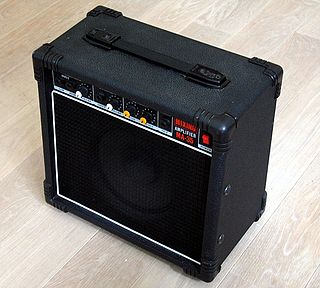
An effects unit or effectspedal is an electronic device that alters the sound of a musical instrument or other audio source.

The Hammond organ is an electric organ invented by Laurens Hammond and John M. Hanert and first manufactured in 1935. Various models have been produced, most of which use sliding drawbars to vary sounds. Until 1975, Hammond organs generated sound by creating an electric current from rotating a metal tonewheel near an electromagnetic pickup, and then strengthening the signal with an amplifier to drive a speaker cabinet. The organ is commonly used with the Leslie speaker.

An electric motor is an electrical machine that converts electrical energy into mechanical energy. Most electric motors operate through the interaction between the motor's magnetic field and electric current in a wire winding to generate force in the form of torque applied on the motor's shaft. Electric motors can be powered by direct current (DC) sources, such as from batteries, motor vehicles or rectifiers, or by alternating current (AC) sources, such as a power grid, inverters or electrical generators. An electric generator is mechanically identical to an electric motor, but operates with a reversed flow of power, converting mechanical energy into electrical energy.

The Leslie speaker is a combined amplifier and loudspeaker that projects the signal from an electric or electronic instrument and modifies the sound by rotating a baffle chamber ("drum") in front of the loudspeakers. A similar effect is provided by a rotating system of horns in front of the treble driver. It is most commonly associated with the Hammond organ, though it was later used for the electric guitar and other instruments. A typical Leslie speaker contains an amplifier, a treble horn and a bass speaker—though specific components depend upon the model. A musician controls the Leslie speaker by either an external switch or pedal that alternates between a slow and fast speed setting, known as "chorale" and "tremolo".

An instrument amplifier is an electronic device that converts the often barely audible or purely electronic signal of a musical instrument into a larger electronic signal to feed to a loudspeaker. An instrument amplifier is used with musical instruments such as an electric guitar, an electric bass, electric organ, synthesizers and drum machine to convert the signal from the pickup or other sound source into an electronic signal that has enough power, due to being routed through a power amplifier, capable of driving one or more loudspeaker that can be heard by the performers and audience.

A guitar amplifier is an electronic device or system that strengthens the weak electrical signal from a pickup on an electric guitar, bass guitar, or acoustic guitar so that it can produce sound through one or more loudspeakers, which are typically housed in a wooden cabinet. A guitar amplifier may be a standalone wood or metal cabinet that contains only the power amplifier circuits, requiring the use of a separate speaker cabinet–or it may be a "combo" amplifier, which contains both the amplifier and one or more speakers in a wooden cabinet. There is a wide range of sizes and power ratings for guitar amplifiers, from small, lightweight "practice amplifiers" with a single 6" speaker and a 10 watt amp to heavy combo amps with four 10” or four 12" speakers and a powerful 100 watt amplifier, which are loud enough to use in a nightclub or bar performance.

A brushless DC electric motor, also known as electronically commutated motor and synchronous DC motors, are synchronous motors powered by direct current (DC) electricity via an inverter or switching power supply which produces electricity in the form of alternating current (AC) to drive each phase of the motor via a closed loop controller. The controller provides pulses of current to the motor windings that control the speed and torque of the motor.

A synchro is, in effect, a transformer whose primary-to-secondary coupling may be varied by physically changing the relative orientation of the two windings. Synchros are often used for measuring the angle of a rotating machine such as an antenna platform. In its general physical construction, it is much like an electric motor. The primary winding of the transformer, fixed to the rotor, is excited by an alternating current, which by electromagnetic induction, causes currents to flow in three Y-connected secondary windings fixed at 120 degrees to each other on the stator. The relative magnitudes of secondary currents are measured and used to determine the angle of the rotor relative to the stator, or the currents can be used to directly drive a receiver synchro that will rotate in unison with the synchro transmitter. In the latter case, the whole device may be called a selsyn.

A DC motor is any of a class of rotary electrical motors that converts direct current electrical energy into mechanical energy. The most common types rely on the forces produced by magnetic fields. Nearly all types of DC motors have some internal mechanism, either electromechanical or electronic, to periodically change the direction of current in part of the motor.
Farfisa is a manufacturer of electronics based in Osimo, Italy. The Farfisa brand name is commonly associated with a series of compact electronic organs and later, a series of multi-timbral synthesizers. Today, the Farfisa brand mainly produces intercom systems with the company Aci Farfisa, which makes and distributes systems for video intercoms, access control, video surveillance, and home automation. The Bontempi group owns the keyboard division Farfisa brand name.

A bass amplifier or "bass amp" is a musical instrument electronic device that uses electrical power to make lower-pitched instruments such as the bass guitar or double bass loud enough to be heard by the performers and audience. Bass amps typically consist of a preamplifier, tone controls, a power amplifier and one or more loudspeakers ("drivers") in a cabinet.

An AC motor is an electric motor driven by an alternating current (AC). The AC motor commonly consists of two basic parts, an outside stator having coils supplied with alternating current to produce a rotating magnetic field, and an inside rotor attached to the output shaft producing a second rotating magnetic field. The rotor magnetic field may be produced by permanent magnets, reluctance saliency, or DC or AC electrical windings.

Bi-amping and tri-amping is the practice of using two or three audio amplifiers to amplify different audio frequency ranges, with the amplified signals being routed to different speaker drivers, such as woofers, subwoofers and tweeters. Biamping can be done with a single power amplifier if the device has more than one amplifier, as the case with a stereo power amp. Triamping cannot be done with a stereo power amp; a mono power amp would need to be added or a home theatre receiver could be used. With bi-amping and tri-amping, an audio crossover is used to divide a sound signal into different frequency ranges, each of which is then separately amplified and routed to separate loudspeaker drivers. In some bass amplifiers using bi-amping, the woofer and horn-loaded tweeter are in the same speaker enclosure. In some bi-amp set-ups, the drivers are in separate speaker enclosures, such as with home stereos that contain two speakers and a separate subwoofer.

Distortion and overdrive are forms of audio signal processing used to alter the sound of amplified electric musical instruments, usually by increasing their gain, producing a "fuzzy", "growling", or "gritty" tone. Distortion is most commonly used with the electric guitar, but may also be used with other electric instruments such as bass guitar, electric piano, and Hammond organ. Guitarists playing electric blues originally obtained an overdriven sound by turning up their vacuum tube-powered guitar amplifiers to high volumes, which caused the signal to distort. While overdriven tube amps are still used to obtain overdrive, especially in genres like blues and rockabilly, a number of other ways to produce distortion have been developed since the 1960s, such as distortion effect pedals. The growling tone of a distorted electric guitar is a key part of many genres, including blues and many rock music genres, notably hard rock, punk rock, hardcore punk, acid rock, and heavy metal music, while the use of distorted bass has been essential in a genre of hip hop music and alternative hip hop known as "SoundCloud rap".

The Fender Vibratone was a Leslie speaker designed for use with electric guitars, manufactured by Fender from 1967-1972. Named after the first Leslie speaker made for the Hammond Organ in 1941, the Vibratone was associated with the electric guitar, although it was used in vocals on many famous songs. The Vibratone was essentially an equivalent of the Leslie 16. A prime example of the Vibratone's sound is on the song "Cold Shot" by Stevie Ray Vaughan.

The Roland VK-7 is an electronic keyboard introduced in 1997 which simulates the sound of an electromechanical Hammond organ. Like other electronic musical instruments that emulate the sound of the electromechanical tonewheel-based organs formerly manufactured by Hammond, the VK-7 is referred to as a clonewheel organ. Currently it is replaced by the VK-8 and the VK-88.

This is a list of jazz and popular music terms that are likely to be encountered in printed popular music songbooks, fake books and vocal scores, big band scores, jazz, and rock concert reviews, and album liner notes. This glossary includes terms for musical instruments, playing or singing techniques, amplifiers, effects units, sound reinforcement equipment, and recording gear and techniques which are widely used in jazz and popular music. Most of the terms are in English, but in some cases, terms from other languages are encountered.
The Wharfedale MACH series of loudspeakers consists of the MACH 3, 5, 7, and 9. This is an informational page devoted to owners and users of these loudspeakers and those interested in history and construction of electronic sound reproduction.

A keyboard amplifier is a powered electronic amplifier and loudspeaker in a wooden speaker cabinet used for amplification of electronic keyboard instruments. Keyboard amplifiers are distinct from other types of amplification systems such as guitar amplifiers due to the particular challenges associated with making keyboards sound louder on stage; namely, to provide solid low-frequency sound reproduction for the deep basslines which keyboards can play and crisp high-frequency sound for the high-register notes. Another difference between keyboard amplifiers and guitar/bass amplifiers is that keyboard amps are usually designed with a relatively flat frequency response and low distortion. In contrast, many guitar and bass amp designers purposely make their amplifiers modify the frequency response, typically to "roll off" very high frequencies, and most rock and blues guitar amps, and since the 1980s and 1990s, even many bass amps are designed to add distortion or overdrive to the instrument tone.
The Korg CX-3 is a clonewheel organ that simulates the sound of an electromechanical Hammond organ and Leslie speaker. The CX-3 was first introduced in 1979.

















